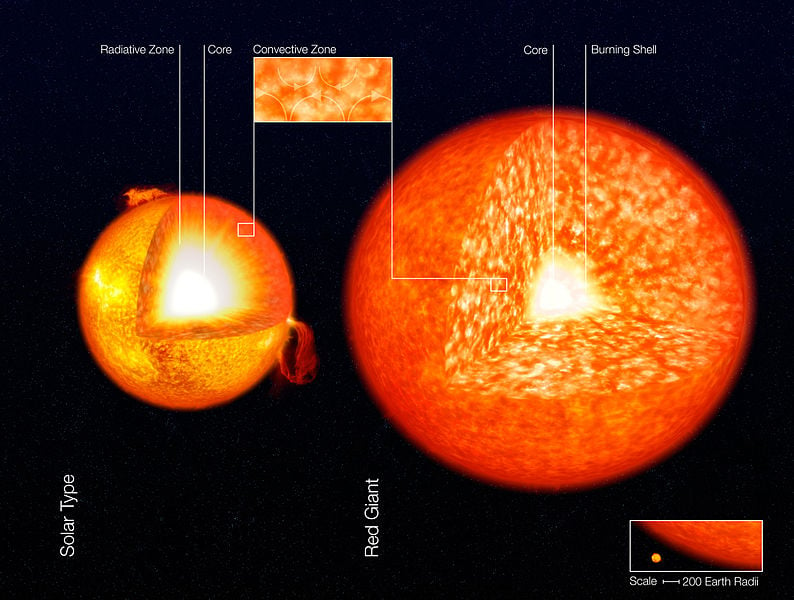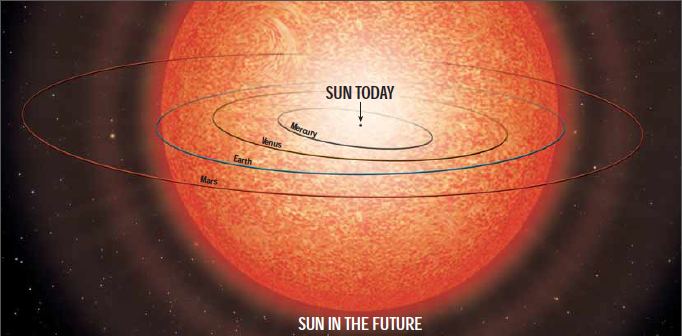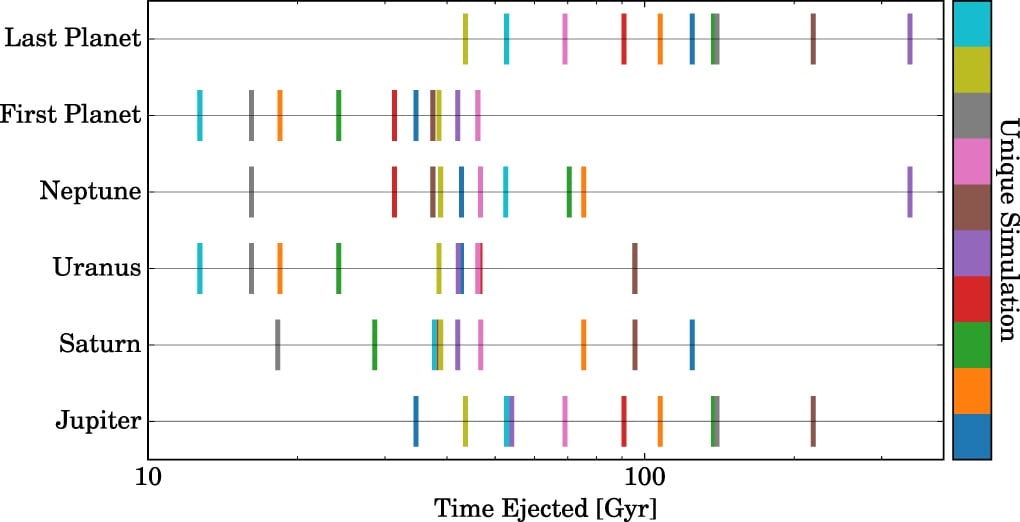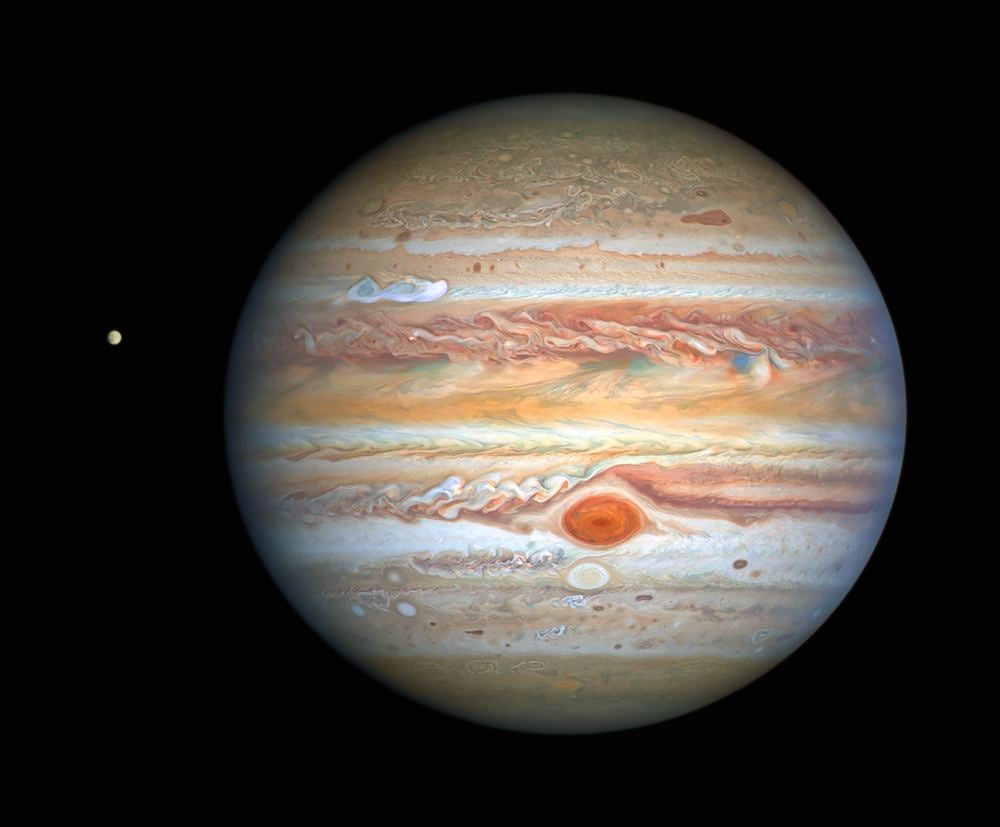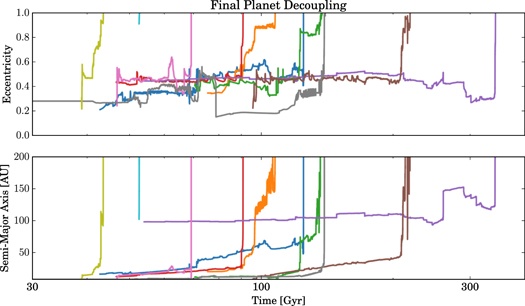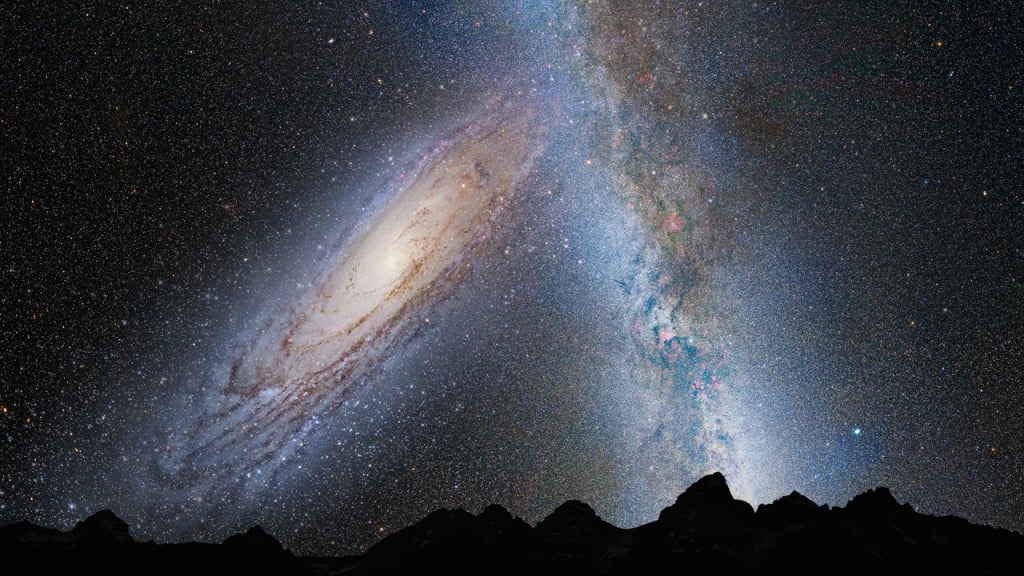Consumption and disintegration.
Next time you want to be the life of the party—if you're hanging out with cool nerds that is—just drop that phrase into the conversation. And when they look at you quizzically, just say that's the eventual fate of the Solar System.
Then adjust your cravat and take another sip of your absinthe.
To the stream of excited follow-up questions that are bound to follow your explanation, you can further explain that the Sun itself and the Milky Way will be the culprit. And then you can mention a new study.
The study is titled " The Great Inequality and the Dynamical Disintegration of the Outer Solar System." The lead author is Jon Zink, a graduate student in UCLA's Division of Astronomy and Astrophysics. The paper is published in The Astronomical Journal.
Humans have long wondered about the eventual fate of the Solar System. In the introduction of their paper, the authors write, "Understanding the long-term dynamical stability of the solar system constitutes one of the oldest pursuits of astrophysics, tracing back to Newton himself, who speculated that mutual interactions between planets would eventually drive the system unstable." But he couldn't explain himself because perturbation theory didn't exist yet.
![200 years ago, Newton wondered if interactions between the planets would eventually make the Solar System unstable. But did he wear a cravat and drink absinthe? Historians are uncertain. Portrait of Isaac Newton (1642-1727) By Godfrey Kneller - http://www.phys.uu.nl/~vgent/astrology/images/newton1689.jpg], Public Domain, https://commons.wikimedia.org/w/index.php?curid=146431](/article_images/593px-Sir_Isaac_Newton_by_Sir_Godfrey_Kneller_Bt.jpg)
Newton was at least partly right. But determining the future of a complicated system like our Solar System is not an easy task, especially since it involves some scientific prognostication into events that take billions of years to unfold.
In this new study, the authors conducted a host of what are called N-body simulations. They're an often-used tool in astronomy and astrophysics. N -body simulations are simulations of dynamic systems of interacting particles, though in this case, the particles are the planets and the Sun itself.
In several billion years, the Sun—the linchpin of the Solar System—will change dramatically. Hydrogen fusion in its core will wind down, and the Sun will leave the main sequence. It'll expand into a red giant, enveloping Mercury, Venus, and probably Earth. (Mars' survival is uncertain, but since its mass is so low, whether it survives or not won't affect the large outer planets much."
You might ask, "Once Earth is gone, who cares what happens next? Why bother with these simulations?" Well, maybe humanity has migrated further out into the Solar System by then. But whether we have or we haven't, we're still driven to know the Solar System's fate.
So, as the Sun expands into a red giant, it'll also begin to lose mass. In fact, it'll likely lose about half of its mass in the next 7 billion years or so. The loss of mass, which anchors the orbits of the Solar System's planets and other bodies, will be extremely disruptive.
The Sun's expansion will mean game over for the inner rocky planets, most likely. But for any humans or their distant, unrecognizable descendants clinging to life in Europa's ocean or someplace else, it'll be game over, too.
Without the Sun's mass to anchor them gravitationally, the Solar System's outer planets will come unglued. Like an aristocrat on a five-day absinthe binge, their orbital behaviour will become unpredictable, erratic. They'll drift further away, out into space.
So far, this is not new knowledge. "Due to solar mass loss—which is expected to remove roughly half of the star's mass—, the orbits of the giant planets expand," the authors write. But Zink and his colleagues wanted to find out what happens after this. According to their work, there'll be another period of relative stability for some of the planets.
"This adiabatic process maintains the orbital period ratios, but the mutual interactions between planets and the width of mean-motion resonances (MMR) increase, leading to the capture of Jupiter and Saturn into a stable 5:2 resonant configuration."
But these expanded orbits, along with other characteristics, make the situation untenable. The new configuration, which lacks the anchoring effect of the Sun's mass, is susceptible to "... perturbations from stellar flyby interactions," the authors write. At this point in their simulations, our unrecognizable Sun is now a white dwarf.
"Accordingly, within about 30 Gyr, stellar encounters perturb the planets onto the chaotic subdomain of the 5:2 resonance, triggering a large-scale instability, which culminates in the ejections of all but one planet over the subsequent ~10 Gyr."
What's the one planet that will resist expulsion? Most likely, Jupiter, our Solar System's most massive planet. Without any companions left, Jupiter will stick around for another 50 Gyr, according to the study. It'll only be removed when a stellar flyby finally sends it packing.
"With an absence of additional planets, the surviving planet lacks a direct mechanism to attain positive energy. The only remaining source of energy exchange is through interactions with passing stars," the authors write in their paper. And they calculate that a star will pass by about every 20 million years.
As the last planet standing, Jupiter's orbital eccentricity will become heightened. "As a result, the expected timescale for the ejection of the post-instability gas giant is decreased by roughly a factor of two (compared to the planetary orbit before the onset of instability). So lonely old Jupiter will be more susceptible to ejection by any passing stars.
If you're envisioning one flyby event in just the right circumstances to eject Jupiter, that's probably not quite right. It's more like 'death by a thousand cuts.'
"Since flyby encounters are rare (entering the 10,000 au sphere once every 23 Myr), and most interactions will have small dynamical effects on the remaining planet, the process of ejection can in principle occur steadily..." Zink and his co-authors write.
Or, maybe not. "On the other hand, given sufficient time, it is also possible that an extremely close encounter will independently liberate the final planet. The underlying mechanism for the removal of the final planet thus represents a competition between these two processes."
This isn't easy to simulate, especially since it'll all happen billions of years from now. Appropriately, the authors pose a question: "In other words, will the final planet be ejected by a single major event or many small energy exchanges?"
The authors offer a couple of caveats, though. One concerns the number of simulations they ran: 10. They acknowledge that their study doesn't amount to solid statistical evidence, but the fact that each simulation produced similar results is still significant. "In all 10 of our simulations, the four gas giants are ejected from the solar system within 1012yr, following the end of solar mass loss," they write.
Another caveat involves the stars that flyby. They modelled flybys of individual stars, but about half of all stars exist in binary pairs. The team excluded those encounters from their simulations, sort of. But they still accounted for them, acknowledging that binary flybys would likely be more disruptive than solitary flybys. "By choosing to exclude these binary encounters, we are making a conservative estimate for the lifetime of the future solar system. In other words, the effect of including binary flybys would further reduce this expected lifetime."
At the very beginning of their paper, the authors suggest caution around their own results. "Unfortunately," they write, "even the most precise N -body simulations are only able to produce time-limited prognosis for the evolution of the solar system. Due to the chaotic nature of the planetary orbits, deterministic forecasting is impossible over sufficiently long timescales."
Of course, the Milky Way itself will change a lot over these extremely long timescales. How will that affect the future of the Solar System?
As the Solar System, or what's left of it, migrates through the galaxy, the outlook may change. "Over the timescales considered in this study, the solar system may undergo radial migration through the Galaxy, encountering regions of differing stellar density and velocity dispersion." But that's almost impossible to model.
Will it migrate outward or inward? Nobody's certain, and nobody's certain if that means the remnant system will encounter fewer stars or more stars. But the encounter rate could vary by three times.
The Milky Way is also expected to collide or merge with the Andromeda galaxy in several billion years. But again, that isn't easy to model at the granular level of individual solar systems. "These changes will impact the rate and velocity of stellar encounters, but accurately estimating these changes remains difficult and is beyond the scope of this present work."
In any case, there's no reason to finish off your bottle of absinthe while keeping one nervous eye on the sky. It's unlikely that humanity will be around to witness any of this. If it's true that 99.9% of all species that have ever existed have gone extinct, we don't have great odds.
But the question around the Solar System's fate is still fascinating. Eventually, the former planetary companions will disperse and drift through space as [rogue planets](https://en.wikipedia.org/wiki/Rogue_planet#:~:text=A%20rogue%20planet%20(also%20termed,not%20orbit%20a%20star%20directly.). If any other smarty-pants species ever spots them, they'll have no clue about their origins and no way of knowing that a certain species of hominid on a certain planet wondered about their eventual fate.
More:
- Press Release: The Eventual Fate of Our Solar System
- Published Research: The Great Inequality and the Dynamical Disintegration of the Outer Solar System
- Universe Today: A Rogue Earth-Mass Planet Has Been Discovered Freely Floating in the Milky Way Without a Star
 Universe Today
Universe Today

